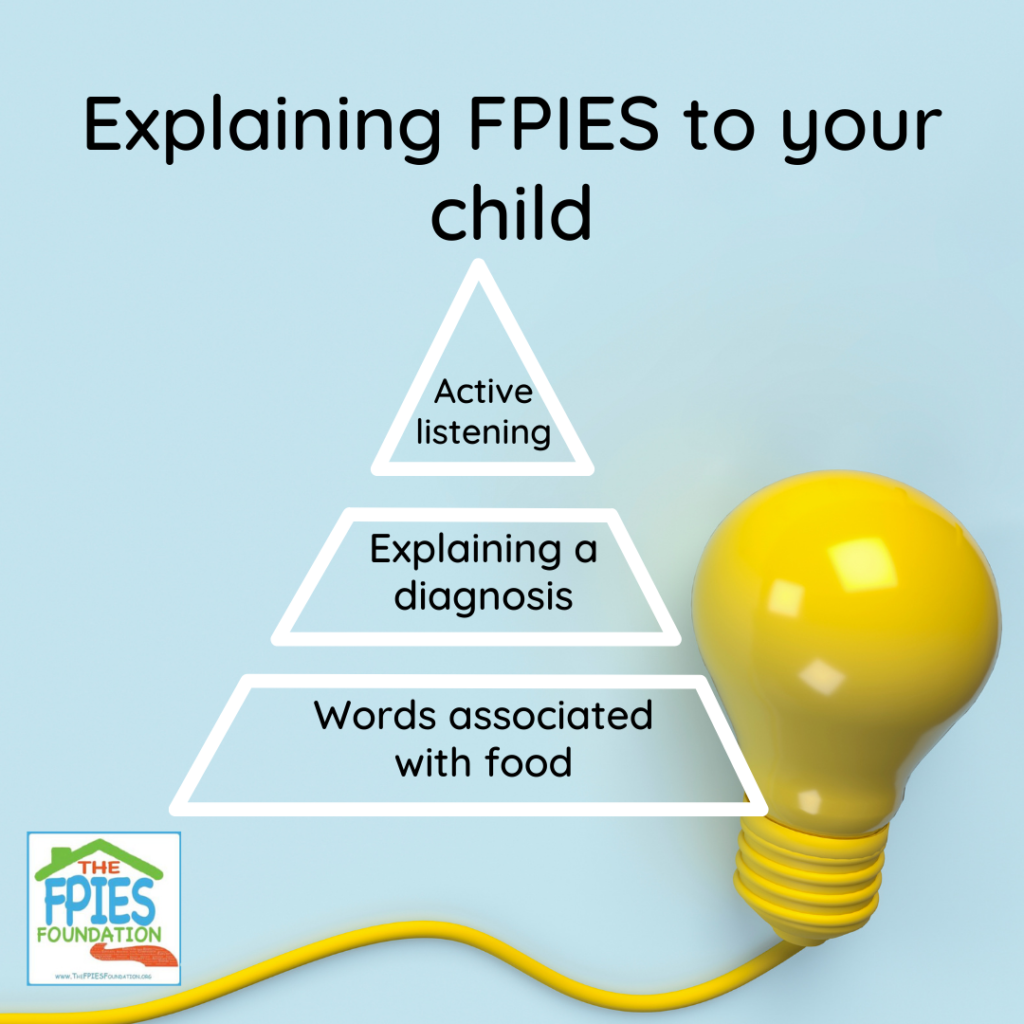Talking about FPIES is a 3-part blog series by Angelika Sharma, FPIES Foundation volunteer.
Explaining FPIES to your child
You may not have conversations with your baby or small child yet, but you are already communicating with them about their FPIES every day. In part three of our Three-Blog-Post Series on communicating about FPIES, we explore communicating about FPIES with the child who has the diagnosis. To do this, we will look at two areas of communication: the early childhood years and the years when children speak and actively ask questions.
Early Childhood: language matters
Many children are infants when they are experiencing their first reactions to trigger foods, so it may seem initially far-fetched to contemplate explaining an FPIES diagnosis to them. However, the time when they absorb and eventually reproduce many of the words they hear can be used proactively to shape the words they associate with meal times and their food allergies.
“Since most children are just starting solids and too small to communicate in words at the time of diagnosis, you may not find yourself in the situation of having to explain their FPIES to your child just yet. Realistically, however, explaining in detail what FPIES is and what safe practices are, are two different things. So, while we may not have to explain the details of FPIES, we may want to begin talking about safe practices around food, just like we do with other things as the little ones explore more and more. “ (Excerpt from “A Mother’s Guide to FPIES” (see link below) )
When becoming conscious of words used around mealtimes you may notice the difference in the following examples:
- Telling a “No” without explanation vs redirecting, such as, “Yes, this is Mama’s food and this is your food,” or, “Yes, you want to try this food. We can make this your next food trial!”
- “Don’t touch that, eat your vegetables” vs highlighting “safe foods”, “your child’s name food”, “yes, this is a food your tummy likes”, “yes, you can have this food, we have tried it before”
By using words that focus on what they can eat or what they have already tried, it is possible to communicate healthy boundaries and how you handle allergies in your home, early on. Having clear ‘red lights ‘or ways of communicating to stop because something is dangerous is, of course, important and helpful beyond food allergies. There will be times when that language is needed, for example, to stop a potential exposure. In other instances, for example, when a child is simply gesturing for a wanted food, rather than being able to reach for it, you may find opportunities to incorporate language that doesn’t negate but drives inclusivity and explains in simple terms.
Little Talkers: answering their questions
For all of the many times, you advocate for your FPIES warrior and they potentially overhear you, there may come a time when they have questions for you. This may start with explaining the diagnosis. Answering their questions as honestly and age-appropriately as possible, your conversation may focus on explaining why you do the things that you do, or perhaps why the things you do are different from the things other children and their families do.
Crucially, by talking about FPIES you also open an ongoing conversation with them: their emotions around being in settings with other children who can eat foods that they cannot; their wants, such as having food that looks similar to what their peers enjoy; their frustration over realizing that this is hard; or their desire to be like other kids.
Sounds hard? We spoke to Joy, Co-Director of The FPIES Foundation, about her experience with her son, Sam, who had shared that he had times he wanted to be like other kids. They spent some time talking and found an opportunity to have his youth soccer team as a place where the other kids did not need to know about his FPIES because they generally do not eat together and his mom was always present on the sidelines.
When Joy didn’t have all the answers, which is entirely normal, she decided to actively listen and involve Sam in the process of coming up with options and that is what worked for them. A lot of this comes down to general parenting choices, but it is worth noting that coming across a range of emotions along the way – on both sides – is normal. Meeting a child where they are at, and creating a safe space to share and listen, is a choice you may want to consider. It can open up your circumstances to where your child is more involved in shaping their day-to-day experiences than before. As in many of life’s chapters, clarity on what you can or cannot change, or defining what boundaries are, may help to guide the focus of conversations in a productive way.

Resources for you:
Kids Corner- What is FPIES to me? https://fpiesfoundation.org/what-is-fpies-to-me/
Kids Corner – Talking to Friends and Family: https://fpiesfoundation.org/kids-talking-to-friends-and-family
Talking About FPIES- Part One: How to Explain FPIES to others: https://fpiesfoundation.org/talking-about-fpies-part-one-how-to-explain-fpies-to-others/
Talking About FPIES – Part Two: Effectively Sharing Your Needs with FPIES: https://fpiesfoundation.org/talking-about-fpies-part-two-effectively-sharing-your-needs-with-fpies/
This 3-part blog series is written by Angelika Sharma. Angelika is mom to Annika, a pandemic baby who was diagnosed with FPIES at 8 months old. Since leaving her corporate career, she focuses on writing and has published two books, including “A Mother’s Guide to FPIES” – a companion to parents with a new FPIES diagnosis.


